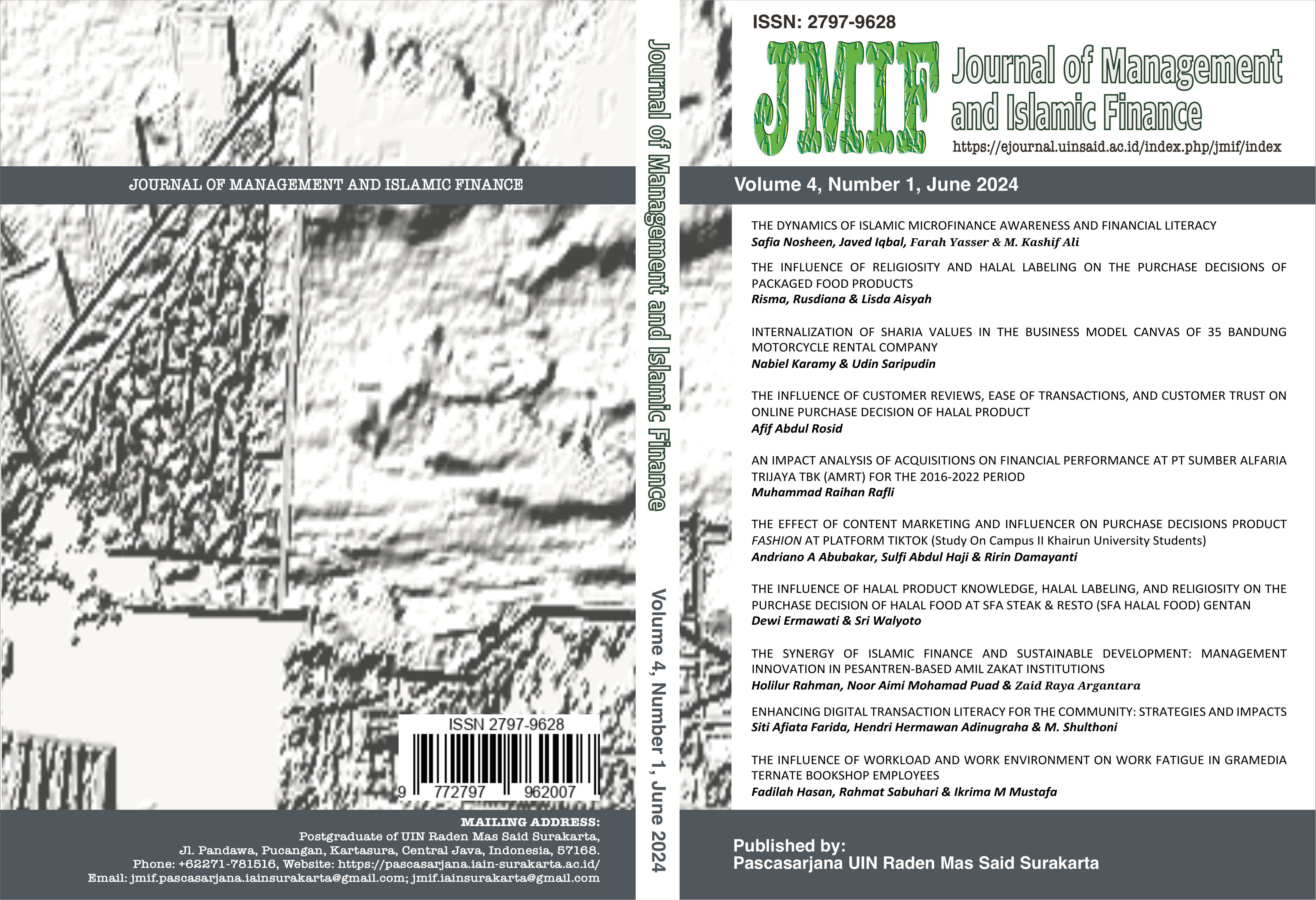THE INFLUENCE OF WORKLOAD AND WORK ENVIRONMENT ON WORK FATIGUE IN GRAMEDIA TERNATE BOOKSHOP EMPLOYEES
DOI:
https://doi.org/10.22515/jmif.v4i1.7380Keywords:
Workload, Work Environment, Work Fatigue, Employee, GramediaAbstract
This study aims to determine the effect of workload and work environment on fatigue i. This research is a quantitative research. The population in this study were all employees at the Gramedia Bookstore Ternate, using a census study sampling method. The analysis technique used in this study was using multiple linear regression analysis , f test and t test with the help of the SPSS 23 version of the IBN application. The results of this study indicate that: (1) Workload has a positive and significant effect on Work Fatigue, (2) Work Environment has a positive and significant effect on Work Fatigue, (3) Workload and Work Environment have a positive and significant effect on Work Fatigue.
Keywords: Workload, Work Environment and Work Fatigue
Downloads
References
Afandi, A. T., & Ardiana, A. (2021). Exploration of the non-physical work environment and burnout syndrome for nurses at the jember regional hospital. Pakistan Journal of Medical and Health Sciences, 15(1), 256–259.
Ancker, J. S., Edwards, A., Nosal, S., Hauser, D., Mauer, E., & Kaushal, R. (2017). Effects of workload, work complexity, and repeated alerts on alert fatigue in a clinical decision support system. BMC Medical Informatics and Decision Making, 17(1), 1–9. https://doi.org/10.1186/s12911-017-0430-8
Appels, A., Siegrist, J., & De Vos, Y. (1997). “Chronic workload”, “need for control” and “vital exhaustion” in patients with myocardial infarction and controls: A comparative test of cardiovascular risk profiles. Stress Medicine, 13(2), 117–121. https://doi.org/10.1002/(SICI)1099-1700(199704)13:2<117::AID-SMI725>3.0.CO;2-J
Arikunto, S. (2001). Dasar-dasar evaluasi pendidikan (Edisi Revi). Bumi Aksara.
Baeriswyl, S., Krause, A., Elfering, A., & Berset, M. (2017). How workload and coworker support relate to emotional exhaustion: The mediating role of sickness presenteeism. International Journal of Stress Management, 24(May), 52–73. https://doi.org/10.1037/str0000018
Barker, L. M., & Nussbaum, M. A. (2011). Fatigue, performance and the work environment: A survey of registered nurses. Journal of Advanced Nursing, 67(6), 1370–1382. https://doi.org/10.1111/j.1365-2648.2010.05597.x
Charoensukmongkol, P. (2022). Supervisor-subordinate guanxi and emotional exhaustion: The moderating effect of supervisor job autonomy and workload levels in organizations. Asia Pacific Management Review, 27(1), 40–49. https://doi.org/10.1016/j.apmrv.2021.05.001
Dix, A., Helmert, J. R., Wagner, T., & Pannasch, S. (2021). Short term effects of workload and extending working hours on exhaustion. Psychology of Everyday Activity, 14(2), 19.
Dung, V., Trang, V. T., & Lan, N. T. M. (2024). Workload doesn’t mean exhaustion: Antecedents of teacher burnout. Journal of Education and E-Learning Research, 11(2), 404–412. https://doi.org/10.20448/jeelr.v11i2.5641
Gore, B. F. (2017). Workload and fatigue. In Space Safety and Human Performance. Elsevier Ltd. https://doi.org/10.1016/B978-0-08-101869-9.00003-0
Grech, M. R., Neal, A., Yeo, G. B., Humphreys, Michael, & Smith, S. (2009). An examination of the relationship between workload and fatigue within and across consecutive days of work: Is the relationshiop static or dynamic? Urnal of Occupational Health Psychology, 14(3), 231–242.
Konze, A. K., Rivkin, W., & Schmidt, K. H. (2017). Is job control a double-edged sword? A cross-lagged panel study on the interplay of quantitativeworkload, emotional dissonance, and job control on emotional exhaustion. International Journal of Environmental Research and Public Health, 14(12). https://doi.org/10.3390/ijerph14121608
Kuncoro, M. (2009). Metode Riset Untuk Bisnis dan Ekonomi: bagaimana Meneliti dan Menulis Tesis? (Edisi ke-3). Erlangga.
Lestari, P. F., Muis, M., Thamrin, Y., Naiem, F., Saleh, L. M., & Alwy, M. (2024). Impact of Work Climate, Workload, and Stress on Fatigue for Improving Health and Work Outcomes. Angiotherapy Research.
Ma’mari, Q. AL, Sharour, L. A., & Omari, O. Al. (2020). Fatigue, burnout, work environment, workload and perceived patient safety culture among critical care nurses. British Journal of Nursing, 29(1), 28–34. https://doi.org/10.12968/bjon.2020.29.1.28
Maghsoud, F., Rezaei, M., Asgarian, F. S., & Rassouli, M. (2022). Workload and quality of nursing care: the mediating role of implicit rationing of nursing care, job satisfaction and emotional exhaustion by using structural equations modeling approach. BMC Nursing, 21(1), 1–10. https://doi.org/10.1186/s12912-022-01055-1
Mahdavi, N., Dianat, I., Heidarimoghadam, R., Khotanlou, H., & Faradmal, J. (2020). A review of work environment risk factors influencing muscle fatigue. International Journal of Industrial Ergonomics, 80(July). https://doi.org/10.1016/j.ergon.2020.103028
Mendes, M., Trindade, L. de L., Pires, D. E. P. de, Biff, D., Martins, M. M. F. P. da S., & Vendruscolo, C. (2020). Workloads in the Family Health Strategy: interfaces with the exhaustion of nursing professionals. Revista Da Escola de Enfermagem, 54, 1–8. https://doi.org/10.1590/S1980-220X2019005003622
Min, A., Kim, Y. M., Yoon, Y. S., Hong, H. C., Kang, M., & Scott, L. D. (2021). Effects of Work Environments and Occupational Fatigue on Care Left Undone in Rotating Shift Nurses. Journal of Nursing Scholarship, 53(1), 126–136. https://doi.org/10.1111/jnu.12604
Mustofani, & Dwiyanti, E. (2019). Relationship between Work Climate and Physical Workload with WorkRelated Fatigue. Indonesian Journal of Occupational Safety and Health, 8(2), 150–157. https://doi.org/10.20473/ijosh.v8i2.2019.150-157
Sillehu, S., Lating, Z., Ibrahim, I., & Lapodi, A. R. (2022). Analysis of the Quality of the Work Environment and Nutritional Status on the Fatigue of Educators. JUMANTIK (Jurnal Ilmiah Penelitian Kesehatan), 7(2), 168. https://doi.org/10.30829/jumantik.v7i2.11032
Sugiyono. (2015). Metode penelitian pendidikan : Pendekatan kuantitatif, kualitatif, dan R&D (Cetakan 21). Alfabeta.
Sugiyono. (2017). MetodePenelitian Kuantitatif, Kualitatif dan R&D. Bandung: PT Alfabet. In Sugiyono. (2017). MetodePenelitian Kuantitatif, Kualitatif dan R&D. Bandung: PT Alfabet. https://doi.org/10.1017/CBO9781107415324.004
Sugiyono. (2020). Metode Penelitian Kuantitatif, Kualitatit dan R&D. Alfabeta.
Tayfur, O., & Arslan, M. (2013). The role of lack of reciprocity, supervisory support, workload and work-family conflict on exhaustion: Evidence from physicians. Psychology, Health and Medicine, 18(5), 564–575. https://doi.org/10.1080/13548506.2012.756535
Downloads
Published
Issue
Section
Citation Check
License
Copyright (c) 2024 Fadilah Hasan, Rahmat Sabuhari, Ikrima M Mustafa

This work is licensed under a Creative Commons Attribution-ShareAlike 4.0 International License.
Authors who publish with this journal agree to the following terms:
- Authors retain copyright and grant the journal right of first publication with the work simultaneously licensed under a Creative Commons Attribution License that allows others to share the work with an acknowledgement of the work's authorship and initial publication in this journal.
- Authors are able to enter into separate, additional contractual arrangements for the non-exclusive distribution of the journal's published version of the work (e.g., post it to an institutional repository or publish it in a book), with an acknowledgement of its initial publication in this journal.
- Authors are permitted and encouraged to post their work online (e.g., in institutional repositories or on their website) prior to and during the submission process, as it can lead to productive exchanges, as well as earlier and greater citation of published work.






